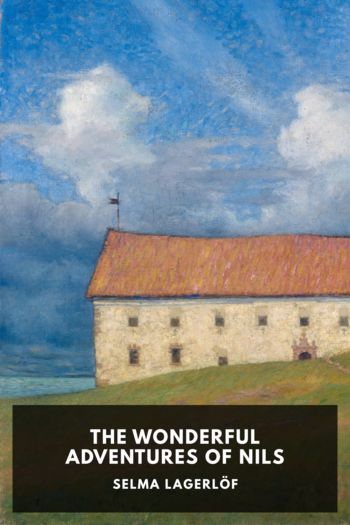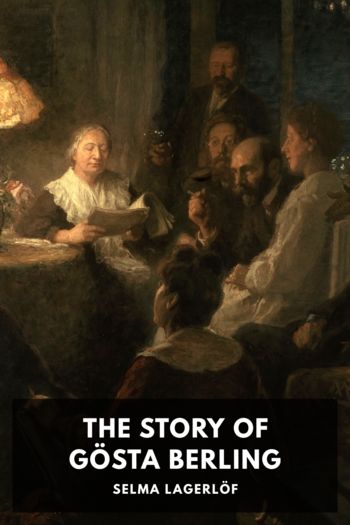The Wonderful Adventures of Nils by Selma Lagerlöf (i can read book club TXT) 📕

Description
In The Wonderful Adventures of Nils, Selma Lagerlöf tells the story of Nils Holgersson, a young boy who is transformed into an elf after a set of misdeeds. Escaping with his family’s farm goose he joins up with a flock of wild geese and travels with them across Sweden as they return to their annual nesting grounds in Lapland.
The story was originally written as a commission for the Swedish National Teachers’ Association to write a geography book for children and has become a firm favourite in the country. It’s been adapted for screen many times, translated into over 30 languages and, until recently, was the artwork on the 20 krona banknote.
Although originally published in English in two volumes—the second starting at “The Story of Karr and Grayskin”—here they are presented as a single combined story.
Read free book «The Wonderful Adventures of Nils by Selma Lagerlöf (i can read book club TXT) 📕» - read online or download for free at americanlibrarybooks.com
- Author: Selma Lagerlöf
Read book online «The Wonderful Adventures of Nils by Selma Lagerlöf (i can read book club TXT) 📕». Author - Selma Lagerlöf
Several flocks of wild geese had already flown by. They flew very high, still he could hear how they shrieked: “To the hills! Now we’re off to the hills!”
When the wild geese saw the tame geese, who walked about the farm, they sank nearer the earth, and called: “Come along! Come along! We’re off to the hills!”
The tame geese could not resist the temptation to raise their heads and listen, but they answered very sensibly: “We’re pretty well off where we are. We’re pretty well off where we are.”
It was, as we have said, an uncommonly fine day, with an atmosphere that it must have been a real delight to fly in, so light and bracing. And with each new wild geese-flock that flew by, the tame geese became more and more unruly. A couple of times they flapped their wings, as if they had half a mind to fly along. But then an old mother-goose would always say to them: “Now don’t be silly. Those creatures will have to suffer both hunger and cold.”
There was a young gander whom the wild geese had fired with a passion for adventure. “If another flock comes this way, I’ll follow them,” said he.
Then there came a new flock, who shrieked like the others, and the young gander answered: “Wait a minute! Wait a minute! I’m coming.”
He spread his wings and raised himself into the air; but he was so unaccustomed to flying, that he fell to the ground again.
At any rate, the wild geese must have heard his call, for they turned and flew back slowly to see if he was coming.
“Wait, wait!” he cried, and made another attempt to fly.
All this the boy heard, where he lay on the hedge. “It would be a great pity,” thought he, “if the big goosey-gander should go away. It would be a big loss to father and mother if he was gone when they came home from church.”
When he thought of this, once again he entirely forgot that he was little and helpless. He took one leap right down into the goose-flock, and threw his arms around the neck of the goosey-gander. “Oh, no! You don’t fly away this time, sir!” cried he.
But just about then, the gander was considering how he should go to work to raise himself from the ground. He couldn’t stop to shake the boy off, hence he had to go along with him—up in the air.
They bore on toward the heights so rapidly, that the boy fairly gasped. Before he had time to think that he ought to let go his hold around the gander’s neck, he was so high up that he would have been killed instantly, if he had fallen to the ground.
The only thing that he could do to make himself a little more comfortable, was to try and get upon the gander’s back. And there he wriggled himself forthwith; but not without considerable trouble. And it was not an easy matter, either, to hold himself secure on the slippery back, between two swaying wings. He had to dig deep into feathers and down with both hands, to keep from tumbling to the ground.
The Big Checked ClothThe boy had grown so giddy that it was a long while before he came to himself. The winds howled and beat against him, and the rustle of feathers and swaying of wings sounded like a whole storm. Thirteen geese flew around him, flapping their wings and honking. They danced before his eyes and they buzzed in his ears. He didn’t know whether they flew high or low, or in what direction they were travelling.
After a bit, he regained just enough sense to understand that he ought to find out where the geese were taking him. But this was not so easy, for he didn’t know how he should ever muster up courage enough to look down. He was sure he’d faint if he attempted it.
The wild geese were not flying very high because the new travelling companion could not breathe in the very thinnest air. For his sake they also flew a little slower than usual.
At last the boy just made himself cast one glance down to earth. Then he thought that a great big rug lay spread beneath him, which was made up of an incredible number of large and small checks.
“Where in all the world am I now?” he wondered.
He saw nothing but check upon check. Some were broad and ran crosswise, and some were long and narrow—all over, there were angles and corners. Nothing was round, and nothing was crooked.
“What kind of a big, checked cloth is this that I’m looking down on?” said the boy to himself without expecting anyone to answer him.
But instantly the wild geese who flew about him called out: “Fields and meadows. Fields and meadows.”
Then he understood that the big, checked cloth he was travelling over was the flat land of southern Sweden; and he began to comprehend why it looked so checked and multicoloured. The bright green checks he recognised first; they were rye fields that had been sown in the fall, and had kept themselves green under the winter snows. The yellowish-gray checks were stubble-fields—the remains of the oat-crop which had grown there the summer before. The brownish ones were old clover meadows: and the black ones, deserted grazing lands or ploughed-up fallow pastures. The brown checks with the yellow edges were, undoubtedly, beech-tree forests; for in these you’ll find the big trees which grow in the heart of the forest—naked in winter; while the little beech-trees, which grow along the borders, keep their dry, yellowed leaves way into the





Comments (0)